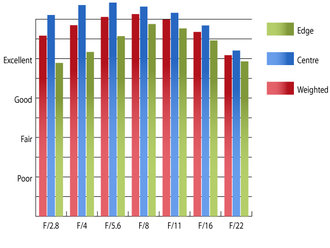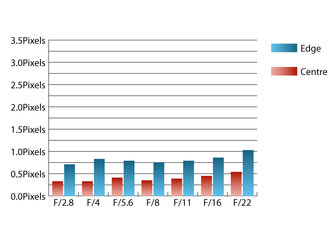Carl Zeiss ZF Distagon T* 15mm f/2.8
Carl Zeiss ZF Distagon T* 15mm f/2.8 Performance
As far as sharpness is concerned, this lens lives up to the reputation Carl Zeiss optics have deservedly earned. At maximum aperture, the clarity in the centre of the image is already outstanding, and the sharpness towards the edges of the frame approaches excellent levels.Stopping the lens down further improves sharpness across the frame, with outstanding clarity being achieved across the frame between f/5.6 and f/11.
 Resolution at 15mm | How to read our chartsThe blue column represents readings from the centre of the picture frame at the various apertures and the green is from the edges. Averaging them out gives the red weighted column.The scale on the left side is an indication of actual image resolution. The taller the column, the better the lens performance. Simple. For this review, the lens was tested on a Nikon D700 using Imatest. |
Chromatic aberrations towards the edges of the frame are reasonably well controlled and shouldn't pose issues for most images, even with high contrast areas towards the edges of the frame. Only at f/22 does fringing exceed one pixel width towards the edges of the frame.
 Chromatic aberration at 15mm | How to read our chartsChromatic aberration is the lens' inability to focus on the sensor or film all colours of visible light at the same point. Severe chromatic aberration gives a noticeable fringing or a halo effect around sharp edges within the picture. It can be cured in software.Apochromatic lenses have special lens elements (aspheric, extra-low dispersion etc) to minimize the problem, hence they usually cost more. For this review, the lens was tested on a Nikon D700 using Imatest. |
Falloff of illumination towards the corners of the frame is quite severe at maximum aperture as the corners of the frame are 3.05 stops darker than the image centre. This level of falloff is so severe, that it can lead to issues with metering as the lens is stopped down, and the corners brighten up relative to the centre of the image. This happen as the camera meters from the light it reads at maximum aperture and more compensation may need to be applied to exposures the more the lens is stopped down. Visually uniform illumination isn't achieved until f/11.
Distortion is relatively mild for a lens with such a wide field of view. Imatest detected 3.04% barrel distortion, which may occasionally pose issues. A slight wave is present in the distortion pattern, which may make critical corrections in image editing software afterwards a little tricky. The wave is only very mild, and is only noticeable if you really go hunting for it.
Shooting into the light is not an issue with this lens. Contrast remains high and flare is rarely an issue. The built in hood does an excellent job of shading the top and bottom of the lens' field of view from extraneous light that may cause issues.
Add your message
Login required
Please login here or if you've not registered, you can register here. Registering is safe, quick and free.
Please login here or if you've not registered, you can register here. Registering is safe, quick and free.
photodo Stats
1102 lenses
428 MTF tests
74 in-depth photodo reviews
100+ users join each day
Help the lens community by reviewing or rating a lens today via our lens search
428 MTF tests
74 in-depth photodo reviews
100+ users join each day
Help the lens community by reviewing or rating a lens today via our lens search
Latest Lens Reviews
- Chinon 28mm f/2.8 Vintage Lens Review
- Canon EF 70-200mm f/4L IS II USM Lens Review
- Samyang AF 85mm f/1.4 EF Review
- Sigma 70mm f/2.8 DG Macro Art Review
- Samyang AF 24mm f/2.8 FE Review
- Meike 50mm f/1.7 Review
- Tamron 70-210mm f/4 Di VC USD Review
- Lensbaby Burnside 35mm f/2.8 Review
- Asahi Super Takumar 50mm f/1.4 Review
- Asahi Super-Multi-Coated Takumar 135mm f/3.5 Review
